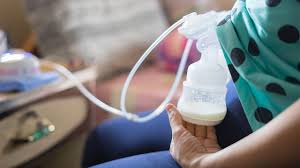Abbie Tomson
Midwife MSc, BSc, Yoga Teacher, Project Lead at All4Birth
@enevlorel
Summary
Expressing milk has become an integral part of breastfeeding for many parents. Expressing refers to the process of extracting milk from the breast, either by hand or using a breast pump. This can be done for various reasons, including feeding the baby, storing milk, increasing supply, or other personal needs. While many people choose to express, it’s important to remember that it’s not mandatory if you don’t feel it’s necessary.
Hand Expressing vs. Pumping
Hand expressing is often recommended, especially in the early stages, because colostrum is thick, sticky, and produced in small amounts. A pump may not be as effective as hand expressing for collecting colostrum. If you choose to express during pregnancy, consult with your health provider and stop if you experience any discomfort or tummy aches.
Pumping
Pumping involves using a device to extract milk. Pumps can be manual (hand-operated) or electric (powered by electricity). They can also be single or double, wireless, wearable, and come in various brands and designs.
Choosing the Right Pump
With numerous brands and types available, selecting the right pump can be overwhelming. Here are some factors to consider:
- Frequency of Use: Determine if you need it for occasional use or daily pumping.
- Purpose: Decide if it’s for increasing supply, pumping at work, or another specific reason.
- Accessibility: Consider if you’ll have access to electricity.
- Budget: More expensive doesn’t always mean better. Choose a pump within your budget that fits your needs.
Getting the Most Out of Pumping
Pumping should be as relaxing and comfortable as possible to ensure effective milk expression. Here are some tips:
- Create a Relaxing Environment: Reduce stress and ensure you’re comfortable.
- Breast Massage: Gently massage your breasts before and during pumping to stimulate milk flow.
- Distraction: Watch a show or listen to music to keep your mind off the process.
- Proper Equipment Maintenance: Regularly replace pump parts, especially the valves, to ensure efficiency
Flange Sizing
The flange is the part of the pump that contacts the breast, that your nipple goes into. It’s crucial to have the correct size for comfort and effectiveness. Most pumps come in standard sizes, but they may not be suitable for everyone. A snug fit is generally more effective than a loose one. You can order different sizes or inserts if the provided flanges aren’t suitable.
Let-Down Catchers
Let-down catchers are simple, one-piece devices that catch milk leaking from one breast while feeding from the other. While they can be handy and cost-effective, frequent use can lead to an oversupply of milk, especially if used during the first six weeks when milk supply is still being established.
Antenatal Hand Expressing
Antenatal hand expressing is a useful technique for collecting colostrum and storing it in the freezer. This can be beneficial if, for some reason, your baby needs extra milk or if you are unable to breastfeed immediately. Not only does this provide a safety net of extra milk, but it also helps you learn how to hand express before your baby arrives. If your baby is reluctant to feed in the first few days, you’ll be able to provide the colostrum they need, while also stimulating your breasts to encourage milk supply.
It’s important to remember that colostrum is produced in very small quantities, so you won’t be expressing ounces of milk. For most people, it will take time and practice to get anything substantial, starting with a glistening on the nipple, then a drop or two, and eventually maybe a millilitre or so- which is normal. When we talk about storing colostrum antenatally, it’s usually a few 1ml syringes- not bottles. If you don’t get that much, or any at all, don’t worry. It is not an indicator of future milk supply.
Some people worry that expressing antenatally will ‘use up’ the supply for the baby, colostrum starts to be made midway through pregnancy and doesn’t transition to the next stage of milk production until after the placenta is born, so there’s no concern about it being used up before the baby arrives.
Most people express directly into a syringe or a clean container and then transfer it to a syringe for storage. You can usually get syringes with caps from your midwife, who may discuss antenatal hand expression with you around 36 weeks. If not, they are available to buy online.
The key thing to remember is to label the syringes individually with your name and date of birth. This is so when you go into the hospital, they can store them and then ‘dispense’ them to you as you need them. Place them into a clean bag or tub before freezing to prevent them from rolling around in the freezer. You don’t necessarily need to take your syringes to the hospital, especially if someone can bring them to you if needed. If you decide to take your supply with you, make sure to transport it with ice packs and inform your maternity team immediately upon arrival so they can store it in the freezer.
Storage of Expressed Breastmilk
Room Temperature: Up to 6 hours.
Refrigerator: Up to 6-8 days at 4°C (39°F) or lower. If it is higher than 4°C, use within 3 days
Freezer: Up to 2 weeks in a freezer compartment or 6 months in a deep freeze (-18°C / 0°F or lower)
- Milk that has been defrosted should be used within 24 hours (to defrost milk, the ideal way is to slowly do it in the fridge over several hours, but you can also sit the bottle or bag in some hot water if you need it quicker)
- Once milk has been offered to the baby, it should be used within an hour, and after that, the unused portion should be discarded or put into the bath.
- To reduce waste- store your expressed milk in small quantities.
Conclusion
Expressing milk can be a valuable tool in your breastfeeding journey. Whether you choose to hand express or use a pump, finding the right method and equipment is key. Always prioritise your comfort and well-being, and seek support when needed.
Links to other resources
 Websites and Guidelines
Websites and Guidelines
La Leche League GB – Friendly breastfeeding support from pregnancy onwards
Breastfeeding | Feeding Your Baby | Start for Life (www.nhs.uk)
 Books
Books
The Positive Breastfeeding Book By Amy Brown
The Mindful Breastfeeding Book: Preparing you for Calm and Connected Feeding By Anna Le Grange
Breastfeeding and the Fourth Trimester by Lucy Webber
 Film, Podcasts and Apps
Film, Podcasts and Apps
Baby Buddy app, created by the Best Beginnings Charity













